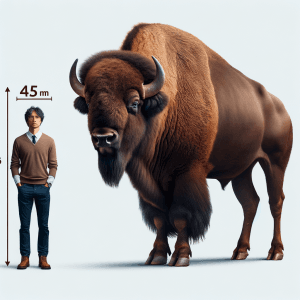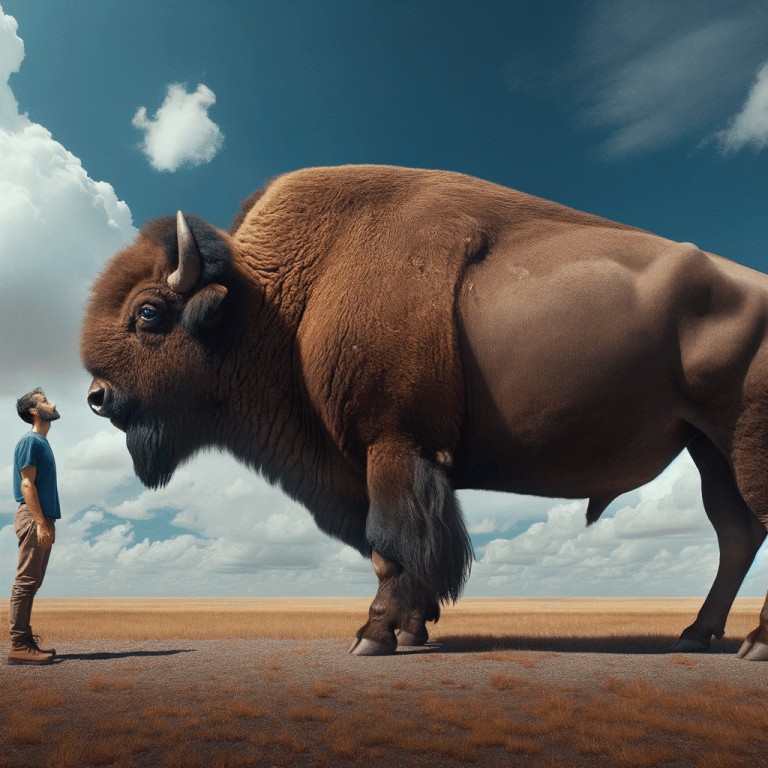Bison and Their Significance
Ever wondered how a bison’s size compares to a human’s? In this article, I’ll explore the physical characteristics, behavior, and habitat of bison, shedding light on their significance in the wild. Get ready to be amazed by some fascinating bison facts!
Discover the Surprising Similarities and Differences Between Bison and Humans
Find out how the weight and height of bison compare to those of humans, and be amazed by the fascinating facts that will change the way you see these majestic creatures and yourself.
Bison Size
When comparing the size of bison to humans, it’s important to note that bison are much larger and heavier than the average person. A full-grown bison can stand up to 6.5 feet (2 meters) tall at the shoulder and weigh as much as 2,000 pounds (907 kilograms), while the average human stands around 5.5 feet (1.7 meters) tall and weighs about 180 pounds (82 kilograms).
Some key physical characteristics of bison include their massive heads, humped shoulders, and shaggy coats, which set them apart from humans in terms of appearance and size.
Bison Behavior
When it comes to bison behavior, these majestic creatures exhibit a range of fascinating traits that set them apart from humans and other animals. Here, we delve into the unique behaviors of bison in the wild, offering a comprehensive understanding of their natural tendencies.
Description of Bison Behavior
Bison are known for their social nature, often congregating in herds for protection and companionship. Their behavior in the wild is characterized by a strong sense of community and cooperation, which is essential for their survival in their natural habitat. Additionally, bison are known to exhibit territorial behaviors, marking their territory and defending it from potential threats.
Comparison to Human Behavior
When compared to human behavior, bison’s social structure and reliance on group dynamics are reminiscent of human societies. However, their territorial instincts and survival strategies differ significantly from those of humans, highlighting the unique nature of bison behavior.
Specific Behaviors Unique to Bison
- Bison engage in wallowing, a behavior where they roll in dust or mud to protect themselves from insects and regulate body temperature.
- During mating season, male bison engage in dramatic displays of dominance and aggression to establish their position within the herd.
- Bison exhibit migratory behaviors, moving across vast distances in search of food and suitable habitats.
By exploring these specific behaviors, we gain a deeper appreciation for the intricacies of bison behavior and their role in the natural world.
 Bison Habitat
Bison Habitat
When it comes to the geographical locations where bison are found, they are primarily located in North America, particularly in the United States and Canada. These vast grasslands and prairies provide the ideal habitat for bison to thrive. In comparison to human habitats, bison prefer open spaces with access to water sources and grazing areas, while humans tend to inhabit more diverse environments, including urban, suburban, and rural areas.
Environmental factors play a crucial role in influencing bison habitats. The availability of food, water, and shelter are essential for the survival of bison herds. Additionally, the impact of human activity, such as agriculture and urban development, has significantly altered the natural habitats of bison, leading to conservation efforts to protect these areas.
Bison Facts
As we delve into the fascinating world of bison, it’s essential to uncover some lesser-known facts about these majestic creatures. Here are some interesting tidbits that shed light on the unique nature of bison:
– Bison Compared to Human: Did you know that an adult bison can weigh as much as 2,000 pounds (907 kg) and stand at a towering height of 6 feet (1.8 meters) at the shoulder? This makes them significantly larger and heavier than the average human, showcasing their impressive physical stature.
– Historical Significance: Bison have played a crucial role in the history and culture of North America, serving as a vital resource for indigenous peoples and early settlers. Their significance in shaping the landscape and ecosystems cannot be understated.
– Conservation Efforts: Due to overhunting and habitat loss, bison populations dwindled to near extinction in the late 19th century. However, concerted conservation efforts have led to a remarkable recovery, with bison now thriving in protected areas across the continent.
– Social Structure: Bison live in tight-knit herds, exhibiting complex social behaviors and communication patterns. Their hierarchical structure and strong family bonds contribute to their resilience as a species.
– Ecological Impact: The grazing and foraging habits of bison have a profound impact on their surrounding habitats, influencing plant diversity and soil health. Their presence is integral to maintaining the ecological balance in grassland ecosystems.
– Symbolism and Iconography: Bison have been revered as symbols of strength, resilience, and freedom in various cultural and artistic representations. Their enduring presence in the collective imagination reflects their enduring significance.
By exploring these intriguing facts, we gain a deeper appreciation for the multifaceted nature of bison and their enduring legacy in the natural world.
Conclusion
In conclusion, this article has provided a comprehensive overview of bison, highlighting their size, behavior, habitat, and interesting facts. The comparison of bison to human characteristics and behaviors offers a unique perspective on these fascinating animals.
By emphasizing specific characteristics, behaviors, and geographical locations, this article aims to inform and educate readers about bison in a clear and straightforward manner. The use of tables, bullet points, and clear explanations ensures that the information is accessible to a broad audience.
Readers are encouraged to further explore bison-related topics and continue learning about these remarkable creatures. Overall, this article serves as a well-structured and informative guide for anyone interested in gaining a comprehensive understanding of bison.


Comments are closed.